
Concept explainers
Draw the products formed when cholesterol is treated with each reagent. Indicate the stereochemistry around any stereogenic centers in the product.
a.
b.
c. PCC
d. oleic acid,
e. [1]
(a)
Interpretation: The product formed on treatment of cholesterol with
Concept introduction: In the presence of base, the hydroxyl group loses its proton to form alkoxide. The alkoxide attacks on the carbonyl carbon of acyl chloride or anhydride to leading to the formation of acyl group and removal of chloride. This process is known as acylation.
Answer to Problem 30.38P
The product formed on treatment of cholesterol with
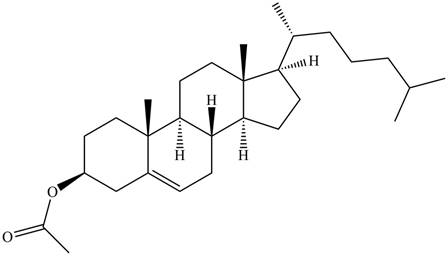
Figure 1
Explanation of Solution
In presence of base and acetyl chloride, the hydroxyl group of cholesterol undergoes acetylation. The corresponding chemical reaction is shown below.

Figure 2
The product formed on treatment of cholesterol with
(b)
Interpretation: The product formed on treatment of cholesterol with
Concept introduction: The addition of
Answer to Problem 30.38P
The product formed on treatment of cholesterol with
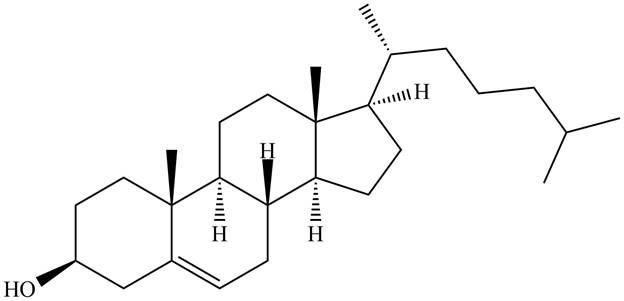
Figure 3
Explanation of Solution
In presence

Figure 4
The product formed on treatment of cholesterol with
(c)
Interpretation: The product formed on treatment of cholesterol with PCC is to be predicted.
Concept introduction: Alcohols are oxidized to different carbonyl compounds depending upon the reagents and alcohol used. In presence of strong oxidizing reagents such as
Answer to Problem 30.38P
The product formed on treatment of cholesterol with PCC is,
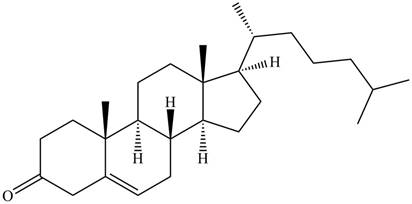
Figure 5
Explanation of Solution
On treatment of cholesterol with PCC, the secondary alcohol is oxidized to ketone. The corresponding chemical reaction is given below

Figure 6
The product formed on treatment of cholesterol with PCC is shown in Figure 5.
(d)
Interpretation: The product formed on treatment of cholesterol with oleic acid,
Concept introduction: In presence of acid, the carboxylic acids are converted to ester using alcohols. This process is known as esterification.
Answer to Problem 30.38P
The product formed on treatment of cholesterol with oleic acid,
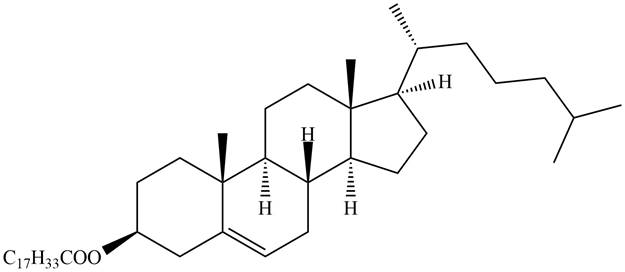
Figure 7
Explanation of Solution
In the presence of acid, the hydroxyl group of cholesterol reacts with oleic acid to form ester. The corresponding chemical reaction is shown below.

Figure 8
The product formed on treatment of cholesterol with oleic acid,
(e)
Interpretation: The product formed on treatment of cholesterol with 1.
Concept introduction: In the presence of borane, hydroperoxide and base the alkenes are converted to alcohols. In this reaction hydrogen atom and hydroxyl groups are added to the double bond. This reaction takes place in anti-markovnikov addition manner. This is a syn addition.
Answer to Problem 30.38P
The product formed on treatment of cholesterol with 1.
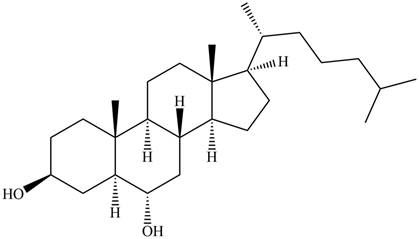
Figure 9
Explanation of Solution
In the presence of borane, hydroperoxide and base the double bond of cholesterol is oxidized to alcohol. The corresponding chemical reaction is shown below.

Figure 10
The product formed on treatment of cholesterol with 1.
Want to see more full solutions like this?
Chapter 30 Solutions
Organic Chemistry
- Predict the intermediate 1 and final product 2 of this organic reaction: NaOMe H+ + 1 2 H H work up You can draw 1 and 2 in any arrangement you like. Note: if either 1 or 2 consists of a pair of enantiomers, just draw one structure using line bonds instead of 3D (dash and wedge) bonds at the chiral center. Click and drag to start drawing a structure. X $ dmarrow_forwardPredict the major products of this organic reaction: 1. NaH (20°C) 2. CH3Br ? Some notes: • Draw only the major product, or products. You can draw them in any arrangement you like. • Be sure to use wedge and dash bonds where necessary, for example to distinguish between major products that are enantiomers. • If there are no products, just check the box under the drawing area. No reaction. Click and drag to start drawing a structure. G Crarrow_forwardPredict the major products of this organic reaction: 1. LDA (-78°C) ? 2. Br Some notes: • Draw only the major product, or products. You can draw them in any arrangement you like. . • Be sure to use wedge and dash bonds where necessary, for example to distinguish between major products that are enantiomers. • If there are no products, just check the box under the drawing area. No reaction. Click and drag to start drawing a structure. Xarrow_forward
- Please draw the structuresarrow_forwardDraw the missing intermediates 1 and 2, plus the final product 3, of this synthesis: 0 1. Eto 1. Eto- 1 2 2. MeBr 2. EtBr H3O+ A 3 You can draw the three structures in any arrangement you like. Explanation Check Click and drag to start drawing a structure.arrow_forwardDraw the missing intermediate 1 and final product 2 of this synthesis: 1. MeO- H3O+ 1 2 2. PrBr Δ You can draw the two structures in any arrangement you like. Click and drag to start drawing a structure.arrow_forward
- What is the differences between: Glyceride and phosphoglyceride Wax and Fat Soap and Fatty acid HDL and LDL cholesterol Phospho lipids and sphingosine What are the types of lipids? What are the main lipid components of membrane structures? How could lipids play important rules as signaling molecules and building units? The structure variety of lipids makes them to play significant rules in our body, conclude breifly on this statement.arrow_forwardWhat is the differences between DNA and RNA for the following: - structure - function - type What is the meaning of: - replication - transcription - translation show the base pair connection(hydrogen bond) in DNA and RNAarrow_forwardWhat is the IP for a amino acid- give an example what are the types of amino acids What are the structures of proteins The N-Terminal analysis by the Edman method shows saralasin contains sarcosine at the N-terminus. Partial hydrolysis of saralasin with dilute hydrochloric acid yields the following fragments: Try-Val-His Sar-Arg-Val His-Pro-Ala Val- Tyr- Val Arg-Val-Tyr What is the structure of saralasin?arrow_forward
- What is the IP for a amino acid- give an example what are the types of amino acids What are the structures of proteins The N-Terminal analysis by the Edman method shows saralasin contains sarcosine at the N-terminus. Partial hydrolysis of saralasin with dilute hydrochloric acid yields the following fragments: Try-Val-His Sar-Arg-Val His-Pro-Ala Val- Tyr- Val Arg-Val-Tyr What is the structure of saralasin?arrow_forward> aw the missing intermediates 1 and 2, plus the final product 3, of this synthesis: 1. Eto 1. EtO¯ H3O+ 1 2 2. PrBr 2. PrBr Δ You can draw the three structures in any arrangement you like. 3 Click and drag to start drawing a structure. Explanation Check 2025 McGraw Hill LLC. All Rights Reserved. Terms of Use Privacarrow_forwardThere are various factors that affect an equilibrium. Give 3 of these factors and explain using examples andequations how an equilibrium is affected by these factors. Please remember that this is a communication question so that you are communicating your understanding of the factors that affect and equilibrium.arrow_forward
 Introduction to General, Organic and BiochemistryChemistryISBN:9781285869759Author:Frederick A. Bettelheim, William H. Brown, Mary K. Campbell, Shawn O. Farrell, Omar TorresPublisher:Cengage Learning
Introduction to General, Organic and BiochemistryChemistryISBN:9781285869759Author:Frederick A. Bettelheim, William H. Brown, Mary K. Campbell, Shawn O. Farrell, Omar TorresPublisher:Cengage Learning
